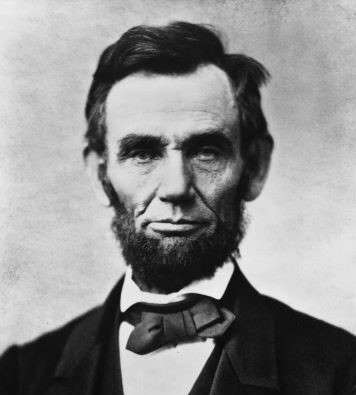Last updated: April 11, 2025
Lesson Plan
Freedom at Antietam

Abraham Lincoln
Library of Congress
- Grade Level:
- High School: Ninth Grade through Twelfth Grade
- Subject:
- Literacy and Language Arts,Social Studies
- Lesson Duration:
- 90 Minutes
- Common Core Standards:
- 9-10.L.1, 9-10.L.2, 9-10.L.5, 9-10.L.6, 11-12.L.1, 11-12.L.2, 11-12.L.5, 11-12.L.6, 9-10.RH.1, 9-10.RH.2, 9-10.RH.4, 9-10.RH.5, 9-10.RH.6, 9-10.RH.8, 9-10.RH.9, 9-10.RH.10, 11-12.RH.1, 11-12.RH.2, 11-12.RH.3, 11-12.RH.5, 11-12.RH.6, 11-12.RH.7, 11-12.RH.8, 11-12.RH.9, 11-12.RH.10, 9-10.RI.1, 9-10.RI.2, 9-10.RI.4, 9-10.RI.6, 9-10.RI.9, 9-10.RI.10, 11-12.RI.1, 11-12.RI.2, 11-12.RI.3, 11-12.RI.5, 11-12.RI.6, 11-12.RI.7, 11-12.RI.8, 11-12.RI.9, 9-10.SL.1, 9-10.SL.2, 9-10.SL.3, 9-10.SL.4, 9-10.SL.5, 9-10.SL.6, 11-12.SL.2, 11-12.SL.3, 11-12.SL.4, 11-12.SL.5, 11-12.SL.6, 9-10.W.1, 9-10.W.2, 9-10.W.3, 9-10.W.4, 9-10.W.5, 9-10.W.6, 9-10.W.7, 9-10.W.8, 9-10.W.9, 9-10.W.10, 11-12.W.1, 11-12.W.2, 11-12.W.3, 11-12.W.4, 11-12.W.5, 11-12.W.6, 11-12.W.7, 11-12.W.8, 9-10.WHST.1, 9-10.WHST.2, 9-10.WHST.4, 9-10.WHST.5, 9-10.WHST.6, 9-10.WHST.7, 9-10.WHST.8, 9-10.WHST.9, 9-10.WHST.10, 11-12.WHST.1, 11-12.WHST.2, 11-12.WHST.4, 11-12.WHST.5, 11-12.WHST.6, 11-12.WHST.7, 11-12.WHST.8, 11-12.WHST.9
- Additional Standards:
- National Center for History in the Schools, UCLA, U.S. History Content Standards, United States Era 5, Civil War and Reconstruction (1850-1877), Standards 1 & 2.
- Thinking Skills:
- Understanding: Understand the main idea of material heard, viewed, or read. Interpret or summarize the ideas in own words. Creating: Bring together parts (elements, compounds) of knowledge to form a whole and build relationships for NEW situations. Evaluating: Make informed judgements about the value of ideas or materials. Use standards and criteria to support opinions and views.
Essential Question
What impact did Lincoln's issuance of the Emancipation Proclamation have on the American People and on the country?
Objective
Evaluate provisions of the Emancipation Proclamation, Lincoln's reasons for issuing it, and its significance.
Explain the causes of the Civil War and evaluate the importance of slavery as a principal cause of the conflict by analyzing the Emancipation Proclamation.
Determine the central ideas or information of a primary or secondary source; provide an accurate summary of the source distinct from prior knowledge opinions.
Background
The Battle of Antietam was the bloodiest single day in American History. On September 17, 1862 over 23,000 soldiers were killed, wounded or missing. The Battle ended the Confederate Army of Northern Virginia's first invasion into the North and led to President Abraham Lincoln's issuance of the preliminary Emancipation Proclamation.
Preparation
Students will need access to the internet to view the primary and secondary sources. These documents can also be downloaded and printed in advance.
Lesson Hook/Preview
"All persons held as slaves ... shall be then, thenceforward, and forever free;" Abraham Lincoln
Procedure
Students will read and evaluate primary and secondary resources and then complete and present a writing assignment based on the point of view of one of the persons they learned about.
During class period one, students will download and read "Freedom at Antietam", the Emancipation Proclamation, and "Contradictions and Divided Loyalties: Slavery on the Antietam Battleground," They will then select and read two additional sources from the list of primary sources below.
During class period two, students will write a newspaper article, letter, or journal entry from the perspective of a person affected (or not affected) by the Emancipation Proclamation. The person they choose to write as can be someone they read about in one of the reading assignments, or a reporter for a Northern, Southern, or abolitionist newspaper; a minister; a free or enslaved person; a former slave holder, etc.
During class period three, students will present and discuss their writing assignments and the teacher will faciliate a discussion using provided discussion questions.
Discussion Questions-
Why do you think the Emancipation Proclamation only freed enslaved people
in areas in rebellion against the Union?
What do you think were Lincoln's reasons for issuing the Emancipation Proclamation?
What were the reasons that the Battle of Antietam helped Lincoln decide to issue the preliminary Emancipation Proclamation?
How do you believe enslaved people responded to the Emancipation Proclamation?
Alternate Procedure-
Assign the research and the writing project as homework and use one class period to present and discuss assignments.
Resources
Primary Sources-
Library of Congress. Born in Slavery: Slave Narratives from the Federal Writers' Project, 1936-1938.
Library of Congress. Voices from the Days of Slavery: Former Slaves Tell Their Story.
Maryland State Archives. Legacy of Slavery in Maryland. (Go to "Browse Collections").
National Archives. The Emancipation Proclamation.
Slaves and Free African Americans, Reports and opinions from the newspapers of Hagerstown, Washington County, and Cumberland, Allegany County, Maryland, 1790 to 1864.
University of North Carolina. North American Slave Narratives.
Secondary Sources-
American Battlefield Trust, Antietam.
Maryland State Archives. Legacy of Slavery in Maryland.
National Archives, The Meaning and Making of Emancipation, ebook.
National Park Service, Antietam National Battlefield. Contradictions and Divided Loyalties: Slavery on the Antietam Battlefield.
National Park Service, Antietam National Battlefield, Freedom at Antietam.
Assessment Materials
Completed writing assignments, student presentations, responses to discussion questions.
Related Lessons or Education Materials
Catoctin Center for Regional Studies, Frederick Community College. Crossroads of Freedom, Maryland and the Border in the Civil War. "In the Classroom."
Library of Congress. The Civil War: The Nation Moves toward War, 1850-61 teacher’s guide primary source set.
Library of Congress. Slavery in the United States: Primary Sources and the Historical Record Student Materials.
Maryland State Archives. Documents for the Classroom.
National Archives, Letter to President Abraham Lincoln from Annie Davis.
National Park Service, Hampton National Historic Site. "Thenceforward, and forever free": Slavery and Freedom in Baltimore lesson plan.
